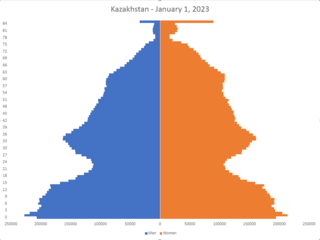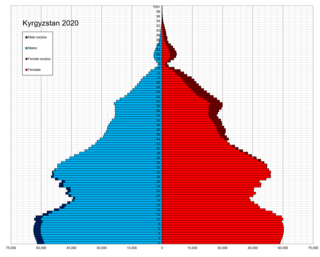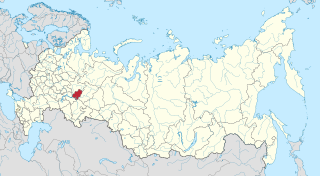
The demographics of Kazakhstan enumerate the demographic features of the population of Kazakhstan, including population growth, population density, ethnicity, education level, health, economic status, religious affiliations, and other aspects of the population. Some use the word Kazakh to refer to the Kazakh ethnic group and language and Kazakhstani to refer to Kazakhstan and its citizens regardless of ethnicity, but it is common to use Kazakh in both senses. According to the UN Department of Economic and Social Affairs, the population of Kazakhstan in 2050 could reach about 27.5 million.

The Demographics of Kyrgyzstan is about the demographic features of the population of Kyrgyzstan, including population growth, population density, ethnicity, education level, health, economic status, religious affiliations, and other aspects of the population. The name Kyrgyz, both for the people and the country, means "forty tribes", a reference to the epic hero Manas who unified forty tribes against the Oirats, as symbolized by the 40-ray sun on the flag of Kyrgyzstan.

The Ossetians, or Alans are an Eastern Iranian ethnic group who are indigenous to Ossetia, a region situated across the northern and southern sides of the Caucasus Mountains. They natively speak Ossetic, an Eastern Iranian language of the Indo-European language family, with most also being fluent in Russian as a second language.

Udmurtia, officially the Udmurt Republic, is a republic of Russia located in Eastern Europe. It is administratively part of the Volga Federal District. Its capital is the city of Izhevsk.

The Kurdish population is estimated to be between 30 and 45 million. Most Kurdish people live in Kurdistan, which today is split between Iranian Kurdistan, Iraqi Kurdistan, Turkish Kurdistan, and Syrian Kurdistan.
Turks in Ukraine are people of Turkish ethnicity living in Ukraine. The first Turkish settlement started during the Ottoman rule of Ukraine. In addition, there has been modern migration to the country largely formed of Meskhetian Turks, followed by immigrants from Turkey and Turkish communities from other post-Ottoman territories, such as Turkish Cypriots from Northern Cyprus.
The Chechen diaspora is a term used to collectively describe the communities of Chechen people who live outside of Chechnya; this includes Chechens who live in other parts of Russia. There are also significant Chechen populations in other subdivisions of Russia.
Turks in Russia, also referred to as Turkish Russians or Russian Turks, refers to people of full or partial ethnic Turkish origin who have either immigrated to Russia or who were born in the Russian state. The community is largely made up of several migration waves, including: descendants of Ottoman-Turkish captives during the Russo-Turkish wars; the Turkish Meskhetian community; and the more recent Turkish immigrants from the Republic of Turkey.

Turks in Kazakhstan are ethnic Turks who live in Kazakhstan, mostly from Meskheti after the Deportation of the Meskhetian Turks.
Turks in Uzbekistan are ethnic Turks who live in Uzbekistan.

The Kurds in Azerbaijan,, form a part of the historically significant Kurdish population in the post-Soviet space. Kurds established a presence in the Caucasus with the establishment of the Kurdish Shaddadid dynasty in the tenth and eleventh centuries. Some Kurdish tribes were recorded in Karabakh by the end of the sixteenth century. However, virtually the entire contemporary Kurdish population in the Republic of Azerbaijan descends from migrants from 19th-century Qajar Iran.
Turks in the former Soviet Union were a relatively small minority within the Soviet Union. However, their presence is considered important within Turkology due to the deportation of thousands of Turks from their home countries. Under the Ottoman Empire, Samtskhe-Javakheti was heavily Islamised producing a Turkish ethnicity within the southwestern region of Georgia. In November 1944, up to 120,000 of these Turks were deported to Central Asia under the rule of Joseph Stalin.

The Circassian diaspora refers to ethnic Circassian people around the world who live outside their homeland Circassia. The majority of the Circassians live in the diaspora, as their ancestors were settled during the resettlement of the Circassian population, especially during the late nineteenth and early twentieth century. From 1763 to 1864, the Circassians fought against the Russian Empire in the Russian-Circassian War, finally succumbing to a scorched-earth genocide campaign initiated between 1862 and 1864. Afterwards, large numbers of Circassians were exiled and deported to the Ottoman Empire and other nearby regions; others were resettled in Russia far from their home territories. Circassians live in more than fifty countries, besides the Republic of Adygea. Total population estimates differ: according to some sources, some two million live in Turkey, Jordan, Syria, and Iraq; other sources have between one and four million in Turkey alone.

Ingiloys are an ethnographic subgroup of Georgians who speak the Ingiloy dialect of Georgian. Ingiloys are indigenous to Saingilo, a cultural and historical region in northwestern Azerbaijan.

Russians are the second largest ethnic minority in Azerbaijan and is also the largest Russian community in the South Caucasus and one of the largest outside of Russia. Although in decline, the community still numbers 119,300 people as of 2009. Since their arrival at the beginning of the 19th century, the Russians have played an important role in all spheres of life, particularly during the Czarist and Soviet period, especially in the capital city of Baku.

The Kurds in Georgia form a major part of the historically significant Kurdish population in the post-Soviet space, and are members of the eponymous ethnic group that are citizens of Georgia. In the 20th century, most Kurds fled religious persecution in the Ottoman Empire to the Russian Empire. The return of their Kurdish surnames needs effort according to a Kurdish activist in Georgia. The Kurds also have their own schools, school books and a printing press in Georgia. Illiteracy among them disappeared in the early 1900s. Kurds in Georgia are politically neutral; however, in 1999 they staged a huge demonstration in Tbilisi, demanding the release of the founder of the Kurdistan Workers' Party, Abdullah Öcalan. Kurds in Georgia today use Cyrillic script. Earlier, in the 1920s, they used the Latin script.

Kurds in Russia form a major part of the historically significant Kurdish population in the post-Soviet space, with close ties to the Kurdish communities in the Caucasus and Central Asia.
Azerbaijanis in Kazakhstan are part of the Azerbaijani diaspora. They are Kazakh citizens and permanent residents of ethnic Azerbaijani background. According to the 2009 census, there were 85,292 ethnic Azerbaijanis living in Kazakhstan; Azerbaijanis comprised 0.5% of Kazakhstan's population and were the country's tenth-largest ethnic minority.
Tatars in Azerbaijan are Azerbaijani citizens and people of Tatar origin. According to the 2009 census, 25,882 Tatars live in the Republic of Azerbaijan. This is 0.29% of the total population.
Accurate or reliable data for historical populations of Armenians is scarce, but various scholars and institutions have proposed estimates for different periods.













